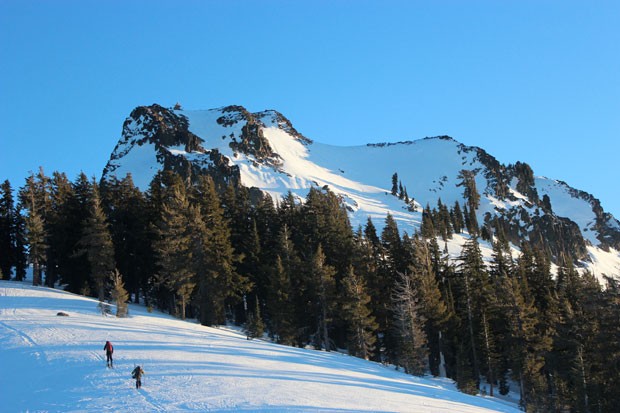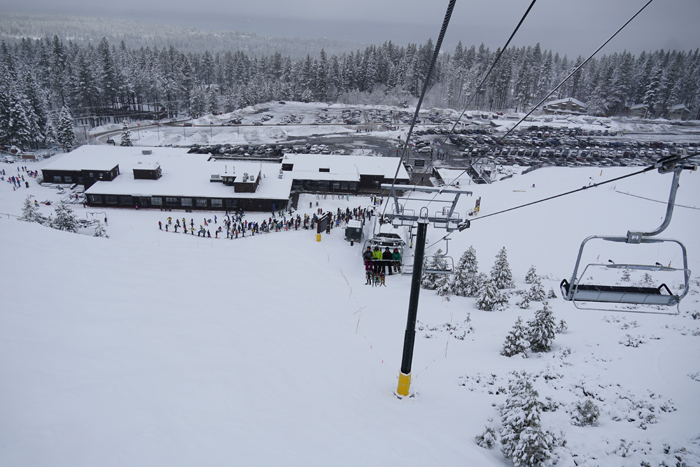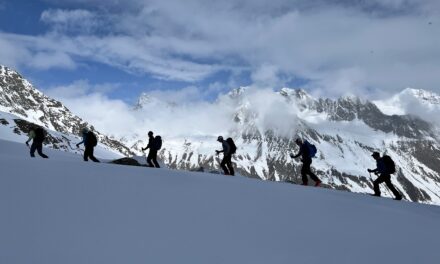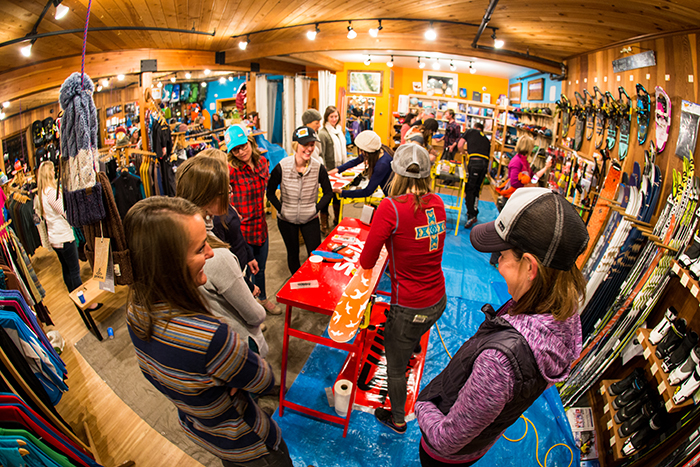- Tahoe’s Nevada Beach Tops the List of Hard-to-Book Campgrounds - 07/17/2024
- Cannabis Watershed Protection Program Cleans Up Illegal Grow Sites - 07/10/2024
- French Fire - 07/05/2024
Lessons learned in Alaska with Snowboarder Jeremy Jones and Teton Gravity Research
Story and photos by Seth Lightcap
Every night I get to sleep under the stars is special but in April 2010 I spent a few nights out that were extraordinary. That spring I joined freeride snowboarder Jeremy Jones and the Teton Gravity Research film crew on a month-long trip to Glacier Bay National Park outside of Haines, Alaska. The mission was to film backcountry freeriding for Jones’ recently released signature movie, Deeper.
Maybe you’ve caught wind of TGR’s Deeper project already, but if not, the film chronicles Jones’ search for next-level wilderness snowboarding terrain on foot — or on splitboards to be precise.
Throughout my two years of working on the project I have learned untold amounts, but nothing compared to lessons I picked up living on a glacier for three weeks with the likes of our guide, Tahoe’s Tom Burt, our lead cinematographer Chris Edmands, and pro shredders such as Xavier Delerue, Josh Dirksen, and of course, Jones.
As a twist on the normal trip report I’d like to share a handful of choice snaps from our expedition, each of which depicts a lesson I picked up somewhere in between climbing snow spines and laying in my sleeping bag wondering if I could feel my pinky toes. Please ponder these images as inspiration and motivation for your own winter expedition as the real message behind the Deeper project is to get off the couch or the computer and get after it!
To learn more about the Deeper project visit tetongravity.com/deeper.
 Keeping our memory cards clear and our camera batteries charged for 25 days of filming on a glacier was a serious undertaking. Deeper production supervisor Chris Edmands ran the main solar charging station which consisted of several Brunton Solar Rolls plugged into a couple Brunton Solo battery packs. Each battery pack could trickle charge a couple camera batteries after a full day in the sun. The Solar Rolls worked decent in overcast skies as well but took longer to charge. To dump memory cards Edmands and I both brought our Mac laptops on the trip. I turned on my computer a dozen times for short ten minute sessions (the time it took to dump 16-32 GB of media) and only after I had spent nearly an hour cuddling with the computer under my down jacket. Warming up the battery paid off as my laptop lasted the entire trip without needing to be charged.
Keeping our memory cards clear and our camera batteries charged for 25 days of filming on a glacier was a serious undertaking. Deeper production supervisor Chris Edmands ran the main solar charging station which consisted of several Brunton Solar Rolls plugged into a couple Brunton Solo battery packs. Each battery pack could trickle charge a couple camera batteries after a full day in the sun. The Solar Rolls worked decent in overcast skies as well but took longer to charge. To dump memory cards Edmands and I both brought our Mac laptops on the trip. I turned on my computer a dozen times for short ten minute sessions (the time it took to dump 16-32 GB of media) and only after I had spent nearly an hour cuddling with the computer under my down jacket. Warming up the battery paid off as my laptop lasted the entire trip without needing to be charged.
 We set up basecamp via ski-plane and Jones’ blind decision on where to drop camp proved to be the critical call of the trip. The zone he chose had a wide diversity of cilmbable lines allowing for a steady terrain progression. All of the riders including Jones rode less committing lines the first few days of the trip to feel out the snow conditions and practice the full body riding techniques necessary for shredding such steep walls. Building up to the big lines paid off as the riders were primed for the exposure and confident in their edges rolling into “no-fall” terrain. Practice did indeed make perfect as the riders stuck every line when the cameras rolled.
We set up basecamp via ski-plane and Jones’ blind decision on where to drop camp proved to be the critical call of the trip. The zone he chose had a wide diversity of cilmbable lines allowing for a steady terrain progression. All of the riders including Jones rode less committing lines the first few days of the trip to feel out the snow conditions and practice the full body riding techniques necessary for shredding such steep walls. Building up to the big lines paid off as the riders were primed for the exposure and confident in their edges rolling into “no-fall” terrain. Practice did indeed make perfect as the riders stuck every line when the cameras rolled.
 Stepping off the ski-plane and on to the glacier, our first concern was snowpack stability. Not only because we wanted to ride and film, but because it would be nice to know that the slope above our camp was not poised to crumble down on top of us while we slept. Tom Burt dug a full profile snow pit straight away and noted no depth hoar or weak layers thankfully. The six to ten feet of snow that fell while we were out there kept us on guard however and Burt would dig at a new pit everyday we toured.
Stepping off the ski-plane and on to the glacier, our first concern was snowpack stability. Not only because we wanted to ride and film, but because it would be nice to know that the slope above our camp was not poised to crumble down on top of us while we slept. Tom Burt dug a full profile snow pit straight away and noted no depth hoar or weak layers thankfully. The six to ten feet of snow that fell while we were out there kept us on guard however and Burt would dig at a new pit everyday we toured.
 No one dropped in without a sluff management plan. The plan was typically to choose traversing lines that kept you moving away from the fall line of your powdery wake. Even brief moments where the riders got caught in their sluff would bobble their line as the heavy moving snow would weigh down their board eliminating some control. As a goofy footer, Jones also chose lines that went right to left and kept him on his toeside – the safety edge.
No one dropped in without a sluff management plan. The plan was typically to choose traversing lines that kept you moving away from the fall line of your powdery wake. Even brief moments where the riders got caught in their sluff would bobble their line as the heavy moving snow would weigh down their board eliminating some control. As a goofy footer, Jones also chose lines that went right to left and kept him on his toeside – the safety edge.
 Here you have the tools of the trade: bomber basecamp tents, a splitboard, “Verts” snowshoes, a shovel and a whippet pole. The two items you may not recognize are the “Verts” and the “Whippet.” The “Verts” are rather small-volume plastic snowshoes that have a fixed heel. They are perfect for post holing up steep pow. The “Whippet” pole is an adjustable height ski pole with a small ice axe blade affixed to the top. It can be used as a self-arrest tool on descent but our main use for it was on ascent as it makes for a lightweight axe that also works for touring low-angle terrain.
Here you have the tools of the trade: bomber basecamp tents, a splitboard, “Verts” snowshoes, a shovel and a whippet pole. The two items you may not recognize are the “Verts” and the “Whippet.” The “Verts” are rather small-volume plastic snowshoes that have a fixed heel. They are perfect for post holing up steep pow. The “Whippet” pole is an adjustable height ski pole with a small ice axe blade affixed to the top. It can be used as a self-arrest tool on descent but our main use for it was on ascent as it makes for a lightweight axe that also works for touring low-angle terrain.
 Our basecamp was located on a small flat ridge in between two glaciers. Lurking crevasses on all sides meant we had to rope up just about any time we left basecamp. Traveling tethered to a partner introduced several new variables to the approach as it was often challenging to keep the perfect pace with your partner while keeping your skis clear of the rope. The goal was to keep the rope loose but fully extended between you such that If one skier unexpectedly fell into a hidden crevasse the other partner could self-arrest and stop their fall. After a few days skinning and switchbacking the ropes became nearly second nature but every once in awhile you’d get caught up in it after a slip or stumble. Having to flick the rope out of your track and whip it to the downhill side on switchbacks definitely kept you on your toes on approach. Thankfully no one fell in any holes so our rope systems were never tested.
Our basecamp was located on a small flat ridge in between two glaciers. Lurking crevasses on all sides meant we had to rope up just about any time we left basecamp. Traveling tethered to a partner introduced several new variables to the approach as it was often challenging to keep the perfect pace with your partner while keeping your skis clear of the rope. The goal was to keep the rope loose but fully extended between you such that If one skier unexpectedly fell into a hidden crevasse the other partner could self-arrest and stop their fall. After a few days skinning and switchbacking the ropes became nearly second nature but every once in awhile you’d get caught up in it after a slip or stumble. Having to flick the rope out of your track and whip it to the downhill side on switchbacks definitely kept you on your toes on approach. Thankfully no one fell in any holes so our rope systems were never tested.
 One of the biggest challenges living on the glacier was trying to keep our gloves and boots dry. When it was storming nothing would dry and when it was sunny we would be using our gear dawn to dusk. To keep our boots livable and our fingers from freezing required careful attention to gear rotation and preparation. The single best answer to the glove issue was to bring several pairs of trusted new gloves. Fresh waterproofing kept them drier to begin with and having an extra set or three allowed you to dry a wet pair at camp during the day. Four different techniques were used to dry out boot liners after long days: Cameraman Gary Pendygrasse brought a propane boot dryer which worked okay but was not very efficient; Jeremy Jones had an extra set of liners that allowed him to switch off day to day; Tom Burt put his feet in plastic bags before putting them in his boots which allegedly kept his foot sweat from soaking through the liner; and the rest of us religiously hung our liners in the group tent overnight and stuffed paper in the toes to soak up a bit of moisture.
One of the biggest challenges living on the glacier was trying to keep our gloves and boots dry. When it was storming nothing would dry and when it was sunny we would be using our gear dawn to dusk. To keep our boots livable and our fingers from freezing required careful attention to gear rotation and preparation. The single best answer to the glove issue was to bring several pairs of trusted new gloves. Fresh waterproofing kept them drier to begin with and having an extra set or three allowed you to dry a wet pair at camp during the day. Four different techniques were used to dry out boot liners after long days: Cameraman Gary Pendygrasse brought a propane boot dryer which worked okay but was not very efficient; Jeremy Jones had an extra set of liners that allowed him to switch off day to day; Tom Burt put his feet in plastic bags before putting them in his boots which allegedly kept his foot sweat from soaking through the liner; and the rest of us religiously hung our liners in the group tent overnight and stuffed paper in the toes to soak up a bit of moisture.













